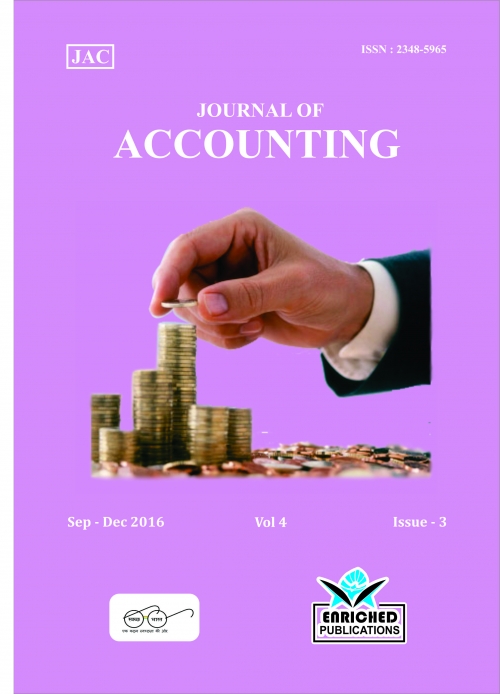GST @18% is applicable against online only subscriptions of journals
|
|
Journal of Accounting |
||
| Volume | : | 12 | |
| Issue | : | 1 | |
| Frequency | : | 3 Issue(s)/Year | |
| Issn | : | 2348-5965 (Print) Applied (Online) |
|
| Journal Impact Factor | : | ||
| Subscribe Now(for 1 year) | |||
| Recommend to: Friend|Librarian | |||
Instructions for author
Essentials for Publishing in this Journal
 Submitted articles should not have been previously published or be currently under consideration for publication elsewhere.
 Conference papers may only be submitted if the paper has been completely re-written (taken to mean more than 50%) and the author has cleared any necessary permission with the copyright owner if it has been previously copyrighted.
 All our articles are refereed through a double-blind process.
 All authors must declare they have read and agreed to the content of the submitted article and must sign a declaration correspond to the originality of the article.
Submission Process
All articles for this journal must be submitted using our online submissions system. http://enrichedpub.com/ . Please use the Submit Your Article link in the Author Service area.
________________________________________________________________
Manuscript Guidelines
The instructions to authors about the article preparation for publication in the Manuscripts are submitted online, through the e-Ur (Electronic editing) system, developed by Enriched Publications Pvt. Ltd. The article should contain the abstract with keywords, introduction, body, conclusion, references and the summary in English language (without heading and subheading enumeration). The article length should not exceed 16 pages of A4 paper format.
Title
The title should be informative. It is in both Journal’s and author’s best interest to use terms suitable. For indexing and word search. If there are no such terms in the title, the author is strongly advised to add a subtitle. The title should be given in English as well. The titles precede the abstract and the summary in an appropriate language.
Letterhead Title
The letterhead title is given at a top of each page for easier identification of article copies in an Electronic form in particular. It contains the author’s surname and first name initial .article title, journal title and collation (year, volume, and issue, first and last page). The journal and article titles can be given in a shortened form.
Author’s Name
Full name(s) of author(s) should be used. It is advisable to give the middle initial. Names are given in their original form.
Contact Details
The postal address or the e-mail address of the author (usually of the first one if there are more Authors) is given in the footnote at the bottom of the first page.
Type of Articles
Classification of articles is a duty of the editorial staff and is of special importance. Referees and the members of the editorial staff, or section editors, can propose a category, but the editor-in-chief has the sole responsibility for their classification. Journal articles are classified as follows:
Scientific articles:
1. Original scientific paper (giving the previously unpublished results of the author’s own research based on management methods).
2. Survey paper (giving an original, detailed and critical view of a research problem or an area to which the author has made a contribution visible through his self-citation);
3. Short or preliminary communication (original management paper of full format but of a smaller extent or of a preliminary character);
4. Scientific critique or forum (discussion on a particular scientific topic, based exclusively on management argumentation) and commentaries.
Exceptionally, in particular areas, a scientific paper in the Journal can be in a form of a monograph or a critical edition of scientific data (historical, archival, lexicographic, bibliographic, data survey, etc.) which were unknown or hardly accessible for scientific research.
Professional articles:
1. Professional paper (contribution offering experience useful for improvement of professional practice but not necessarily based on scientific methods);
2. Informative contribution (editorial, commentary, etc.);
3. Review (of a book, software, case study, scientific event, etc.)
Language
The article should be in English. The grammar and style of the article should be of good quality. The systematized text should be without abbreviations (except
standard ones). All measurements must be in SI units. The sequence of formulae is denoted in Arabic numerals in parentheses on the right-hand side.
Abstract and Summary
An abstract is a concise informative presentation of the article content for fast and accurate Evaluation of its relevance. It is both in the Editorial Office’s and the author’s best interest for an abstract to contain terms often used for indexing and article search. The abstract describes the purpose of the study and the methods, outlines the findings and state the conclusions. A 100- to
250- Word abstract should be placed between the title and the keywords with the body text to follow. Besides an abstract are advised to have a summary in English, at the end of the article, after the Reference list. The summary should be structured and long up to 1/10 of the article length (it is more extensive than the abstract).
Keywords
Keywords are terms or phrases showing adequately the article content for indexing and search purposes. They should be allocated heaving in mind widely accepted international sources (index, dictionary or thesaurus), such as the Web of Science keyword list for science in general. The higher their usage frequency is the better. Up to 10 keywords immediately follow the abstract and the summary, in respective languages.
Acknowledgements
The name and the number of the project or programmed within which the article was realized is given in a separate note at the bottom of the first page together with the name of the institution which financially supported the project or programmed.
Tables and Illustrations
All the captions should be in the original language as well as in English, together with the texts in illustrations if possible. Tables are typed in the same style as the text and are denoted by numerals at the top. Photographs and drawings, placed appropriately in the text, should be clear, precise and suitable for reproduction. Drawings should be created in Word or Corel.
Citation in the Text
Citation in the text must be uniform. When citing references in the text, use the reference number set in square brackets from the Reference list at the end of the article.
Footnotes
Footnotes are given at the bottom of the page with the text they refer to. They can contain less relevant details, additional explanations or used sources (e.g. scientific material, manuals). They cannot replace the cited literature.
The article should be accompanied with a cover letter with the information about the author(s): surname, middle initial, first name, and citizen personal number, rank, title, e-mail address, and affiliation address, home address including municipality, phone number in the office and at home (or a mobile phone number). The cover letter should state the type of the article and tell which illustrations are original and which are not.





